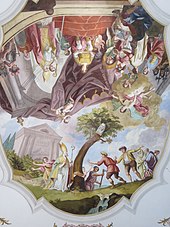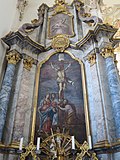St. Martin (Thaining)
The Catholic parish church of St. Martin in Thaining , a parish in the Upper Bavarian district of Landsberg am Lech , was built in the second half of the 18th century on the site of a late Gothic predecessor church. The church is dedicated to St. Martin von Tours and belongs to the diocese of Augsburg . It is elevated above the center of the village and is surrounded by a cemetery. The Thaininger Martinskirche is one of the protected architectural monuments in Bavaria.
history
A first pastor is recorded in Thaining for the year 1070. In 1490 a previous church was consecrated, which was probably built on the site of a Romanesque choir tower church . This church was completely replaced by a new building in the Rococo style between 1762 and 1764 under the direction of the Landsberg master builder Nikolaus Schütz, a student of Dominikus Zimmermann . The new church was consecrated in 1770. The tower was completed in 1783/84 by the master mason Rochus Schelkle, also from Landsberg.
architecture
Exterior construction
The exterior is structured by a surrounding eaves cornice and color-contrasting corner pilasters . The high windows are curved in a three-pass shape, the apex of the choir is broken through by a small round window at the top and a shell-shaped window at the bottom.
In the northern corner of the choir rises the 48-meter-high bell tower, which is covered by a pointed spire and structured by corner pilasters and cornices. Numerous narrow, loopholes-like openings have been cut into the lower floors, and the bell storey has a large sound opening on each of its four sides, framed by a basket arch .
In the southern corner of the choir is the two-storey sacristy covered with a tent roof . It is broken through by small, baroque curved kidney windows. To the west of the sacristy, on the south side of the nave , the outer staircase to the pulpit and a sign are attached. Another sign is on the north side of the nave.
inner space
The interior, a spacious hall structure , consists of a four-axis nave and a retracted choir with a three-eighth end . The choir and nave are covered by flat needle cap barrels. The walls are structured by pilasters, standing on high plinths and only slightly protruding from the wall, with Corinthian- inspired volute capitals and strong entablature pieces . A strongly flattened basket arch leads to the two-bay choir, which opens onto an oratorio on both sides . The western end of the nave is formed by a double gallery with curved parapets resting on wooden pillars .
Stucco and paintings
The stucco , which is limited to the vault in the choir and the capitals of the pilasters, was carried out by the builder Nikolaus Schütz himself. The stucco decor is only painted on in the nave.
The frescoes are dedicated to the legend of St. Martin, the patron of the church . They are marked with the year 1764 and were created by the Munich painter Franz Kirzinger . On the ceiling fresco in the choir, St. Martin is depicted as an advocate before the Trinity , the two pictures in the nave remind of the miracle of trees and you can see the church patron before Emperor Magnus Maximus in Trier . The division of the mantle is shown above the gallery and the death of the saint in front of the choir arch. The cartouches on the side in the choir contain further scenes from the life of St. Martin, in the nave two miracles can be seen as well as the four Latin church fathers Ambrosius , Gregory the Great , Augustine and Hieronymus and the four evangelists Luke , John , Mark and Matthew .
On the parapets of the oratorios a plague procession in 1649 is depicted on the left and the stoning of St. Stephen on the right .
Furnishing
- The six-column high altar with its twisted, blue marbled columns and its elaborately carved excerpt crowned by the Archangel Michael was originally created by Heinrich Hett from Dießen am Ammersee in 1724 for the parish church of St. Remigius in Raisting and came to Thaining in 1773. The altar sheet with the depiction of the donation of the cloak by Saint Martin was painted by Franz Kirzinger like the extract picture showing the dream vision of the church patron.
- The two carved figures on the side of the high altar from 1768, St. John Nepomuk and St. Laurentius , date from the time the church was built.
- The side altars were made by Anton Fichtner around 1790, the altar paintings were made by Peter Schmid from Pflugdorf in 1814. The crucifixion of Christ is depicted on the left altar and the baptism of Jesus on the right altar. The partially gold-plated carved figures on the right altar are attributed to the Luidl workshop in Landsberg, the sculpture group of Anna selbdritt from around 1700 Lorenz Luidl and the half-figures of two bishops from around 1730 to his son Johann Luidl .
- The white and partially gold-plated pulpit from 1791 is also a work by Anton Fichtner. The trumpet angel from the same year on the sound cover comes from Nikolaus Hartl, the four putti on the pulpit are probably works by Johann Luidl from around 1710.
- The choir and lay stalls , the communion bench , the oratorio bars, the confessionals , the church doors as well as the baptismal font and the Mount of Olives group in the sign also belong to the construction-time equipment of the church .
- Numerous sculptures were taken over from the previous building in today's church. These include the figures of the twelve apostles from around 1695, the figure of John the Baptist from the same period, and the figures of St. Anne and St. Joachim in the choir, which are dated around 1710.
- The oldest piece of equipment in the church is the colored, Gothic Madonna and Child on the cafeteria of the north side altar, which dates from the second quarter of the 15th century.
- The sacristy still has the furniture created by Anton Fichtner and marked with the year 1767. It is one of the rare surviving examples of a sacristy in the late Rococo style .
literature
- Georg Dehio : Handbook of the German art monuments. Bayern IV: Munich and Upper Bavaria . 2nd edition, Deutscher Kunstverlag, Munich 2002, ISBN 3-422-03010-7 , p. 1159.
- Karl Gattinger, Grietje Suhr: Landsberg am Lech, city and district (= Bavarian State Office for Monument Preservation [Hrsg.]: Monuments in Bavaria . Volume I.14 ). Verlag Friedrich Pustet, Regensburg 2014, ISBN 978-3-7917-2449-2 , p. 755-758 .
Web links
- Parish Church of St. Martin Diocese of Augsburg
Individual evidence
- ↑ Parish Church of St. Martin, Diocese of Augsburg
- ↑ List of monuments for Thaining (PDF) at the Bavarian State Office for Monument Preservation, monument number D-1-81-142-1
Coordinates: 47 ° 58 ′ 23.5 " N , 10 ° 57 ′ 23.4" E












